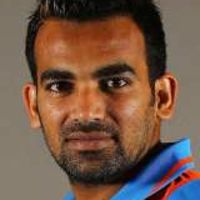Australia 430 (Hussey 146, Ponting 123, Zaheer 5-91, Ishant 4-77) and 228 for 6 dec (Watson 41, Ishant 3-40) drew with
India 360 (Zaheer 57*, Harbhajan 54, Dravid 51) and 177 for 4 (Tendulkar 49, Laxman 42*)
Scorecard and ball-by-ball details
How they were out
|
|
|

VVS Laxman concentrated hard and helped India secure the draw
© AFP
|
|
| |
Five days on a cracking pitch could not separate Australia and India, who will head to Mohali for Friday's second Test at 0-0 after playing out a draw in Bangalore. VVS Laxman and Sachin Tendulkar helped grind out the result - or lack of - which was a pleasing outcome for India after Australia dominated the first couple of days.
Hoping for another
Sydney, Ricky Ponting set India 299 from 83 overs but his attack lacked the firepower to blast through India's resolute middle order. For the full five days the surface had featured crevices so wide that, had the wiry Ishant Sharma gone missing, you would know where to look. Strangely, it continued to play relatively well throughout. Occasional deliveries spat and bounced while others stayed low but batsmen who applied themselves could survive.
However, scoring remained difficult and once Virender Sehwag departed cheaply, India's target was largely irrelevant. As Tendulkar, Gautam Gambhir and Laxman held off Australia's bowlers it began to look like the only celebration would be a personal one as Tendulkar closed in on Brian Lara's all-time Test run-scoring record. Even that party was put on hold when Tendulkar fell 14 short of Lara's mark.
At least he made a major contribution to saving a game Australia will feel they should have won. The parallels with Sydney for much of the final day were obvious: again India were set a target that was all but out of reach and again they went to tea with seven wickets in hand.
But the Chinnaswamy Stadium is not the SCG. In Sydney more was happening, both off the field and on it. In that game an average of 321 runs were scored each day; in this Test the figure was 239. And in Sydney the game finished with the sun still shining; in Bangalore bad light interrupted proceedings when Australia required miracles.
Viewed in its entirety, the hard-fought match was like Test cricket of old. Five full days of relatively low-scoring play without a result provided the starkest possible contrast to the IPL, which was the last major cricket played in Bangalore. Consecutive sixes were commonplace in the IPL; there weren't two in this entire Test.
It didn't stop the deafening roars from the crowd as Tendulkar and Laxman fought off Australia's attack. Tendulkar put together two incredibly valuable partnerships that all but secured the draw after India lost two early wickets that gave Australia a sniff. He combined with Gambhir for a 53-run stand and then added 61 with Laxman. The responsibility was then passed on to Laxman and Sourav Ganguly, who prodded away the spin and built a 39-run partnership that took India through to the close.
Laxman's concentration was complete. He watched the ball closely, defended with ease and did not get bogged down at one end. The same could be said of Tendulkar, until a momentary slip-up that gave Cameron White an experience he will never forget - he picked up Tendulkar as his first Test wicket. White threw up a delivery outside off and drew Tendulkar into an airy drive that was snaffled at cover. A teary White, Test legspinner, celebrated just over a week after playing as a batting allrounder in club cricket in Melbourne.
The lack of a truly dangerous frontline slow bowler did restrict Australia. Michael Clarke and White sent down 38 overs between them and, although they gave the batsmen moments of trouble, rarely did they look like running through the order. Nor could the fast bowlers provide the necessary spark, although they threatened to light a fuse early in India's innings. It seemed like India's batting order would break apart quicker than the deceptive pitch when they lost Sehwag and Rahul Dravid within the first nine overs.
Sehwag, the one man who might have made Ponting nervous about the target, was taken at first slip off Stuart Clark having been dropped by Brad Haddin off the previous Brett Lee over. India's 16 for 1 became 24 for 2 when Dravid flicked Lee to short midwicket, where Ponting dived acrobatically to take the catch.
It gave Australia's captain reason to believe that batting into the final day - the lower order added 35 to the overnight total - was not a bad decision. His attack simply didn't have the time or weaponry to finish the task. It meant no real answers to the two primary questions that hung over Australia in the lead-up: could a pair of half-spinners add up to a whole, and could the fast bowlers prove matchwinners in India.
The hosts entered the Test with a query or two as well. India's Fab Four were under pressure and while Laxman, Tendulkar and Ganguly were major reasons the game was saved, rarely in either innings did they look like dominating Australia's bowlers. Anil Kumble was also being pressed on his retirement plans; his rickety right shoulder and failure to take a wicket have done nothing to suppress those questions.
After five days, 30 wickets and 1195 runs, neither side can claim to be especially better off than the other. It's time for Mohali.
Brydon Coverdale is a staff writer at Cricinfo


